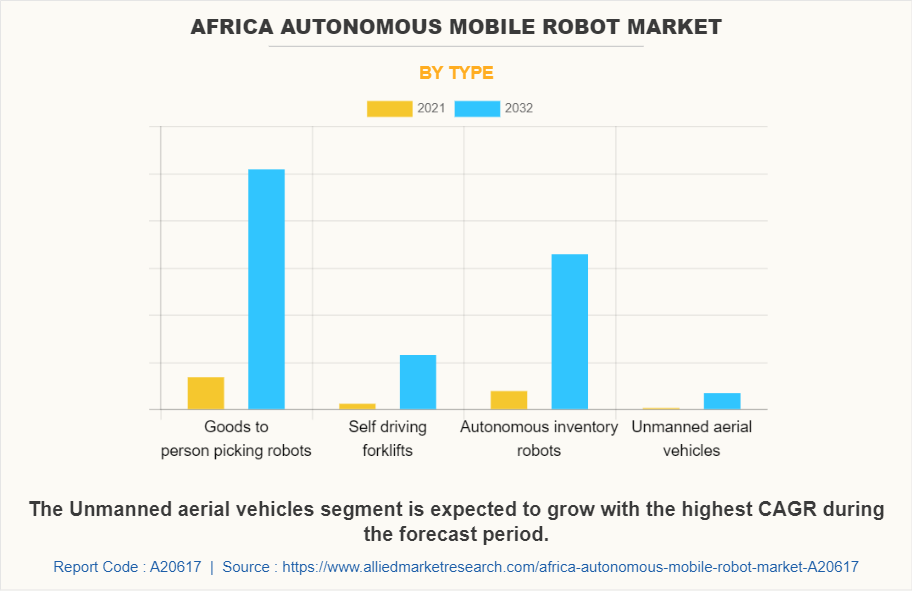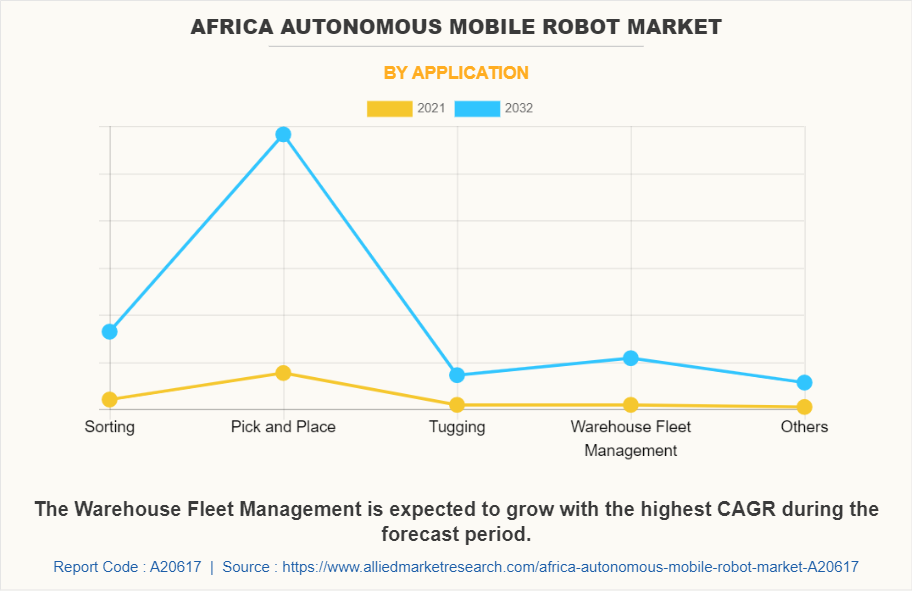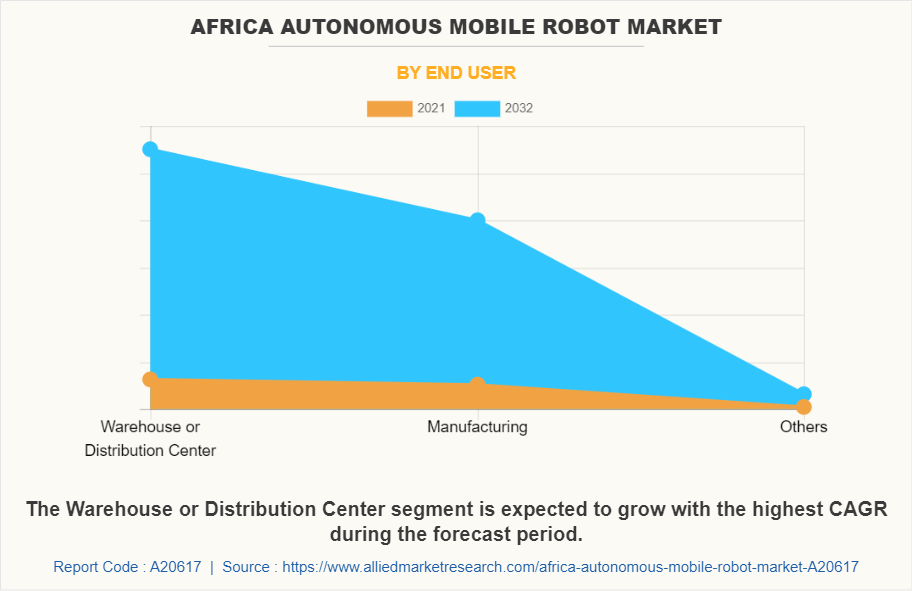Africa Autonomous Mobile Robot Market Overview
The Africa autonomous mobile robot market was valued at $35.5 million in 2021, and is projected to reach $308.9 million by 2032, registering a CAGR of 21.5%.
The Africa autonomous mobile robot encompasses the design, manufacturing, deployment, and integration of mobile robotic systems across sectors such as logistics, manufacturing, healthcare, agriculture, and retail. These robots are equipped with navigation systems, sensors, cameras, software platforms, and control systems that allow them to operate independently within dynamic environments. The market plays an increasingly important role in advancing automation, enhancing productivity, reducing operational costs, and addressing labor shortages across industries in the region.

Key Takeaways
The Africa Autonomous Mobile Robot Market share covers 20 countries. The research includes a segment analysis of each country in terms of value ($million) for the projected period 2021-2032.
More than 1,500 product literatures, industry releases, annual reports, and other such documents of major decorative coatings industry participants along with authentic industry journals, trade associations' releases, and government websites have been reviewed for generating high-value industry insights.
The study integrated high-quality data, professional opinions and analysis, and critical independent perspectives. The research approach is intended to provide a balanced view of markets and to assist stakeholders in making educated decisions to achieve their most ambitious growth objectives.
The Africa Autonomous Mobile Robot Market has experienced steady growth, fueled by the expansion of e-commerce, rising adoption of smart warehouses, advancements in manufacturing, and increased demand for efficient material handling. Companies are investing in autonomous mobile robots to improve delivery speed, optimize inventory management, and reduce downtime. The expansion of industrial hubs, rapid urbanization, and digital transformation efforts across African economies are also contributing to the adoption of autonomous mobile robots. In addition, industries are recognizing the importance of flexibility, with autonomous mobile robots offering scalability and adaptability to different business operations.
Also, technological progress is another major factor shaping the market. Advancements in artificial intelligence, machine learning, computer vision, and sensor technologies have enabled robots to perform complex tasks with higher accuracy and efficiency. These capabilities support autonomous navigation, obstacle avoidance, and real-time data sharing with warehouse management and enterprise resource planning systems. Integration of Internet of Things (IoT) devices and cloud platforms allows autonomous mobile robots to work collaboratively within connected ecosystems, driving more intelligent decision-making and predictive analytics.
The regulatory and policy environment across Africa also plays a role in shaping adoption. Governments are encouraging digital transformation and industrial automation as part of broader economic diversification strategies. Policies promoting smart manufacturing, logistics efficiency, and technology-driven agriculture are creating opportunities for companies to implement autonomous mobile robot solutions. Safety standards, data protection laws, and investments in digital infrastructure, such as 5G connectivity, further influence how autonomous mobile robots are deployed in different industries.
Furthermore, operational challenges in logistics and supply chains are also pushing demand for autonomous mobile robots. Many regions face inefficiencies due to port congestion, limited road infrastructure, and labor shortages in material handling and distribution. autonomous mobile robots provide a solution by enhancing throughput, reducing human error, and enabling around-the-clock operations. Their ability to integrate with automated storage and retrieval systems, as well as their use in last-mile delivery, positions them as critical assets for addressing supply chain bottlenecks in African markets.
In addition to this, sustainability is emerging as an important driver of autonomous mobile robot adoption. Many organizations are focusing on reducing energy consumption and carbon footprints while improving efficiency. autonomous mobile robots powered by rechargeable batteries, energy-efficient navigation systems, and optimized routing algorithms align with sustainability goals. The growing shift toward green logistics and environmentally conscious manufacturing further strengthens the case for autonomous mobile robots as part of future-ready operations.
Despite the strong growth potential, the market faces notable challenges. High initial investment costs, limited access to advanced technologies in certain regions, and insufficient technical expertise present barriers to widespread adoption. Supply chain disruptions, fluctuations in hardware component prices, and integration complexities with legacy systems can also slow market expansion. Additionally, small and medium enterprises may find it difficult to justify the upfront capital required for autonomous mobile robot deployment without clear return-on-investment models.
Nevertheless, opportunities such as increasing digital literacy, rising investments in smart infrastructure, and growing collaborations between technology providers and local enterprises are expected to drive adoption of autonomous mobile robots. Expansion of sectors such as online retail, healthcare logistics, and precision agriculture create further demand for autonomous mobile robots tailored to local needs. Strategic partnerships among robot manufacturers, software developers, and logistics providers will continue to define competition in the market, as companies aim to deliver solutions that combine safety, efficiency, and sustainability.
The Africa autonomous mobile robot market is segmented into type, application and end user & region. By type, the market is bifurcated into goods to person picking robots, self-driving forklifts, autonomous inventory robots & unmanned aerial vehicles. By application, it is classified into sorting, pick and place, tugging, warehouse fleet management & others. By end user, it is divided into warehouse or distribution center, manufacturing & others. Region wise, it is analyzed across Africa.

Based on types, the goods to person picking robots segment dominated the market. This is due to the rapid growth of e-commerce and retail sectors in Africa, where efficient order fulfillment and faster delivery times have become critical competitive factors. These robots help optimizes warehouse operations by reducing travel time for workers, minimizing picking errors, and increasing throughput in distribution centers. The segment is also benefiting from the rising adoption of automated fulfillment solutions by logistics providers and retailers seeking to handle increasing online shopping volumes while keeping operational costs under control.

Based on application, pick and place accounted for the largest market share and are projected to lead during the forecast period. This is due to high demand for automation in warehouses, manufacturing units, and distribution centers, where rapid and precise handling of goods is critical for operational efficiency. Pick and place robots help reduce manual labor, minimize errors, and accelerate throughput, making them ideal for repetitive and high-volume tasks.

Based on end user, the warehouse or distribution center held the highest market share, owing to the increasing demand for automation in material handling, inventory management, and order fulfillment processes. The need to improve operational efficiency, reduce labor dependency, and minimize human error has driven widespread adoption of autonomous mobile robots in these facilities. Autonomous mobile robots help optimize storage space, enable faster and more accurate picking and packing, and facilitate seamless integration with warehouse management systems.
Competition Analysis
The key players included in the Africa Autonomous Mobile Robot Market analysis are BlueBotics SA, Vecna Technologies, Inc., ABB Ltd., Omron Adept Technologies, Inc., Intelligent Motion Systems, Inc., Kollmorgen Corporation, OnRobot A/S, YRH Robotics Technologies Co., Ltd., PAL Robotics, Clearpath Robotics, Inc.
Key Benefits For Stakeholders
- Enable informed decision-making process and offer market analysis based on the current market situation and estimated future trends.
- Analyze the key strategies adopted by major market players in Africa autonomous mobile robot market.
- Assess and rank the top factors that are expected to affect the growth of Africa autonomous mobile robot market.
- Top Player positioning provides a clear understanding of the present position of market players.
- Detailed analysis of Africa's Autonomous mobile robot market segmentation assists to determine the prevailing market opportunities.
- Identify key investment pockets for various offerings in the market.
Africa Autonomous Mobile Robot Market Report Highlights
| Aspects | Details |
| Forecast period | 2021 - 2032 |
| Report Pages | 74 |
| By Type |
|
| By Application |
|
| By End User |
|
| Key Market Players | YRH Robotics Technologies Co., Ltd., BlueBotics SA, OnRobot A/S, Vecna Technologies, Inc., Kollmorgen Corporation, Intelligent Motion Systems, Inc., ABB Ltd., Omron Adept Technologies, Inc., PAL Robotics, Clearpath Robotics, Inc. |
The Africa Autonomous Mobile Robot Market is projected to grow at a CAGR of 21.5% from 2021 to 2032
BlueBotics SA, Omron Adept Technologies, Inc., OnRobot A/S, Intelligent Motion Systems, Inc., ABB Ltd., YRH Robotics Technologies Co., Ltd., PAL Robotics, Clearpath Robotics, Inc., Vecna Technologies, Inc., Kollmorgen Corporation are the leading players in Africa Autonomous Mobile Robot Market
1. Enable informed decision-making process and offer market analysis based on current market situation and estimated future trends.
2. Analyze the key strategies adopted by major market players in africa autonomous mobile robot market.
3. Assess and rank the top factors that are expected to affect the growth of africa autonomous mobile robot market.
4. Top Player positioning provides a clear understanding of the present position of market players.
5. Detailed analysis of the africa autonomous mobile robot market segmentation assists to determine the prevailing market opportunities.
6. Identify key investment pockets for various offerings in the market.
Africa Autonomous Mobile Robot Market is classified as by type, by application, by end user
Loading Table Of Content...
Loading Research Methodology...



